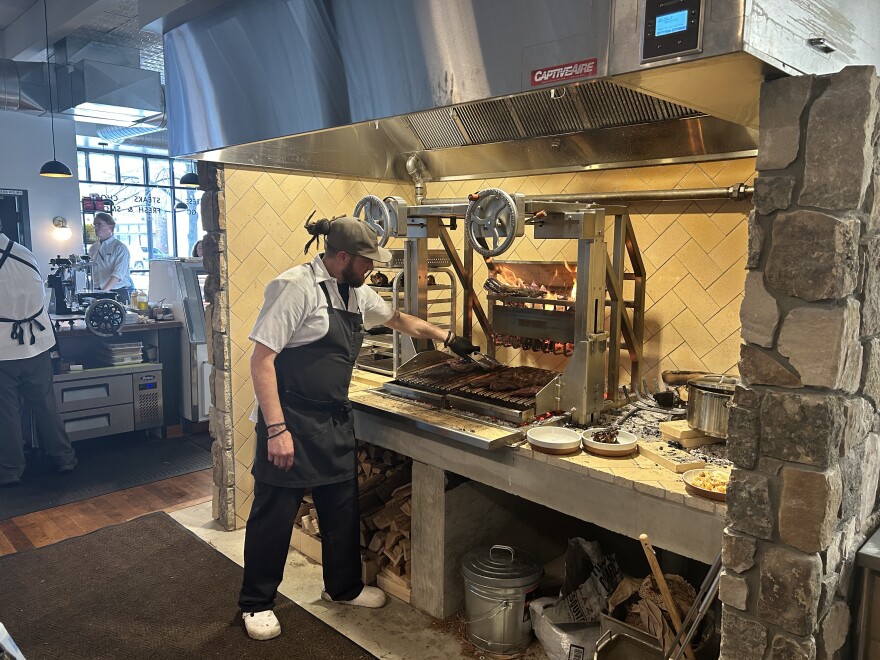On opening night of The Union restaurant in downtown Helena, heat pulses off a wood-fired grill where chefs sear steaks, pork chops and thick slices of sourdough bread.
Every ounce of meat served here was raised on one of five ranches within 150 miles of the restaurant.
Around the corner from the grill is a butcher case, selling everything from beef ground in house, to teres major, a specialty shoulder cut.
Farm-to-table restaurants aren’t uncommon, but a locally-sourced restaurant owned and operated by the ranchers who raise the meat they serve - is. It’s part of an ongoing effort among some ranchers to control more of the livestock supply chain that for decades has been dominated by a handful of international meat packing companies -- Tyson, JBS, Cargill and National Beef.
Sous chef Seth Sanderson says The Union, cooperatively owned by the ranchers whose beef is served, is different from any other kitchen he’s been in.
“It's about good people taking care of the land and noticing that the way we've been treating each other and our communities, animals, and like the picture as a whole on a small scale isn't sustainable and isn't really healthy,” Sanderson said.

This new restaurant in Helena trying to get around the big supply chain is part of the Old Salt Co-Op of regional ranches. Helmville rancher Cole Mannix founded the group to give producers control of how their livestock are sold.
“You're just at the mercy of the people who ultimately have access to the customer. The end retailer that is ultimately selling to the customer has all of the power,” Mannix said.
According to datafrom the US Department of Agriculture's Economic Research Service, the four largest meatpacking firms handle 85% of all beef and 67% of all pork consumed in the country.
Animals from Old Salt’s member ranches are slaughtered at a facility in Big Timber, and then butchered and packaged at the co-op’s facility in Helena.
Mannix grew up watching his family build direct-to-consumer sales, but still had to rely on the meatpacking giants to get most of their cattle to market.
“You probably could not have picked a harder food problem to go tackle. And yet at the same time, I think everybody involved in Old Salt feels like the only thing riskier than what we were doing is the status quo,” Mannix said.
He hopes the combination of a restaurant and butcher shop will succeed as one more option to get local rancher’s meat in front of customers.
Walt Schweitzer with the Montana Farmers Union says soaring operation costs, and meat packing industry consolidation take meat out of state and leaves ranchers fighting for slim profit margins.
He said one of the best ways to fix this problem is bringing back local meatpacking.
“The big four are able to negotiate a better deal to get access to their meat counters. And the individual producers, well you won't see, local meat product in Walmart because they just don't allow it,” Schweitzer said.
Co-ops have popped up across the state to build producer-run processing plants. Farmers Union helped start one in Havre a few years ago.
Going one step further, and running a restaurant and butcher shop to sell those cuts of meat gives ranchers even more support, and the freedom to control how they’re ranching. For Mannix, that means ranching the way he wants to.
“Land is kin. Instead of, ‘we own the land’ that we belong to the land. And it's our role to do our best to leave it better. And that means soil health. And it means habitat and it means streams.,” Mannix said.
Mannix says producers being disconnected from their customers, and customers not knowing where the food on their plate came from, is the root of many agriculture problems.
“If ranches can be more diverse in their markets, get a better price for their products, be more stable over time. They have the time, bandwidth and resources to invest back in land stewardship,” Mannix said.
This kind of ranching is more expensive. Beef from Old Salt costs about 30% more than what you’ll find in many grocery stores . Mannix and his partners are betting on customers placing that additional value on their approach.
For Ryan Murphy who just finished eating dinner at The Union with his family, this approach is worth the extra cost.
“I’m willing to pay a premium for that to know where our food is coming from and that it’s supporting good people,” Murphy said.
Time will tell if the ranch-to-restaurant model will work. Mannix says he’s terrified, but also hopeful. The restaurant's opening three nights’ of reservations were booked.
EDITOR’S NOTE: For transparency we are noting that Old Salt is a financial supporter of Montana Public Radio. But that played no role in this report.
Copyright 2024 Montana Public Radio


